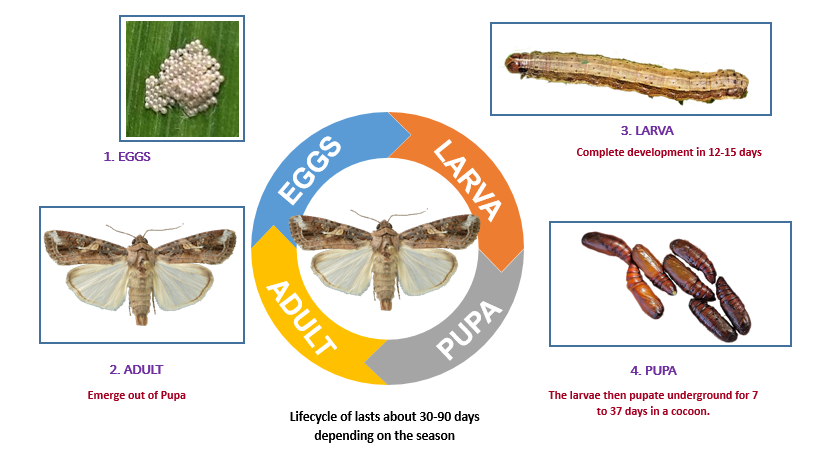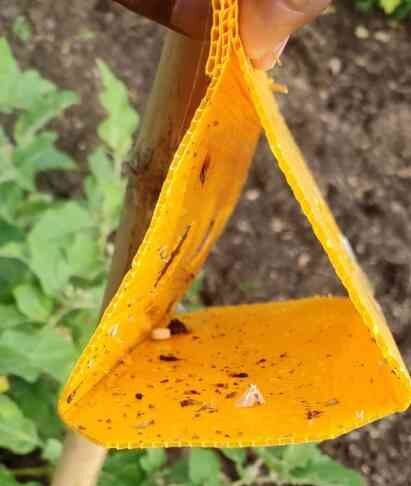Fall Armyworm in Maize
Fall Armyworm
Maize is the third most important cereal crop in India. It is grown in a wide range of environments all over India. Among the maize growing countries, India rank 4th in the area and 7th in the production. Though the productivity in India is almost half of the world the average per day productivity of Indian maize is at par with many lead maize producing countries. Maize consumption can broadly be divided into three categories viz. Feed, food and Industrial non-food products (mainly starch). The most important use and demand driver of maize is poultry and cattle feed which accounts for 65 % of total maize consumption. Nearly 8 per cent of maize is consumed by humans.
Fall armyworm (FAW) also called as Spodoptera frugiperda is a destructive pest invaded India recently and causing huge economic damage in maize. The incidence of this pest was first observed in the state of Karnataka and later reported in Tamil Nadu, Andhra Pradesh, Telangana, Maharashtra, Madhya Pradesh, Odisha, Bihar, West Bengal, Gujarat, Chhatisgarh and Kerala at mild to alarming levels in farmer’s fields. Its rapid spread to more than 90% of maize-growing areas of India within a short span. It impose a major challenge to small-holder maize farmers, maize-based industry.


Life Cycle of Fall Armyworm
The lifecycle of fall armyworm is around 30 days during summer and 60 days during the spring and autumn seasons, 80-90 days during the winter. A female will typically lay about 1500 eggs in her life span. The number of generations a moth will have in a year depends on the weather.
Egg: The eggs are dome-shaped, and measures around 0.4 millimetres in diameter and 0.3 millimetres in height. Females lay eggs on the underside of leaves. If the population is very high, females lay eggs anywhere. In warm weather, the eggs will hatch into larvae within a few days.
Larva: The next stage of lifecycle is larva. It is most destructive stage. The larvae go through six different instars, each varying slightly in physical appearance and pattern. This stage last for anywhere from 14 to 30 days depending on temperatures. The mature caterpillar is about 38–51 mm in length. The larvae have biting mouth parts. The larva has a distinctive inverted Y suture on the forehead.
Pupa: The larvae then pupate underground for 7 to 37 days in a cocoon. Duration and survival of the pupal stage depend on the temperature of the environment.
Adult Insect: The adults live for about 10 days to 21 days. The female laying most of her eggs early in life. Adults are nocturnal and fare best during warm and humid nights.
Nature of Damage :
- The early emergence in the crop life cycle, voracious feeding habit, large-scale aggressive behaviour, high reproduction, fast migration, and irreversible nature of crop damage, all made FAW a key pest.
- FAW attacks all stages of maize crop from seedling emergence to ear development.
- The young larvae of FAW feed in and around the whorl leaves leaving a silvery transparent membrane resulting into papery spots.
- The damage also results in pinhole symptoms on the leaves.
- Older larvae remain and feed inside the whorl. The damages by late instars (4th instar onwards) result in extensive defoliation of leaves and presence of large amounts of faecal pellets in whorls.
- Damage during vegetative stage leads to leaf damage
- Damage during reproductive stage leads to damage to the corn ear and the kernels.
- The damage by FAW results in significant yield losses, reduction in yield and poor quality of the yield.



Benefits of Pheromone Traps:
We in GreenCore BioSolutions™ provides innovative crop protection strategy from plant-damaging pests that is beneficial for grower, consumer and maintain ecological balance. PheroTrap Solutions™ developed a pheromone-based unique solid tablet dispenser that is easy to apply in the field and safe to the applicant, and benign to the environment.
Our technology only targets the pest that is nuisance to the crop and thereby provide better pest-management program to balance farming-ecology.
- Increased trapping efficiency.
- Easy, safe and economical to install as compared to spraying insecticides.
- More efficient in the management of insecticide resistance.
- Next generations of Fall Armyworm would be reduced, if installed immediately after initial period of sowing .
- Reduced use of pesticides.
- Sustained under various climatic conditions.
- Long life with controlled release of pheromone from our unique solid tablet dispenser.
- Persistent release of pheromone from the trap.
Directions to use Pheromone Traps :
- Either funnel trap, water trap or delta trap works well when combined with our formulation to trap Fall Armyworm.
- Install 4-5 traps per acre for monitoring and 10-15 traps for mass trapping depending on the level of infection.
- For the water trap, we recommend using soap water and water should be replaced from time to time.
- Installation of traps can be done one week after sowing.
- 4 traps with pheromone tablets should be placed around corners and 4 traps in the middle of the field. The minimum distance between two traps should be 4 feet.
- Trap height should be adjusted according to plant height every week. For water trap, a 2 feet trap height can be maintained. Traps should be placed at a height of 2 feet of the crop.



